

There are two main reasons for this phenomenon:
a) Diffusion of responsibility - the feeling of less individual responsibility when there are more people present
b) Pluralistic ignorance - the belief that one feels different from the social norm and hence rejects own private opinions eg. The Emperor's New Clothes is one such classic children's story demonstrating this concept
Another reason also cited in some studies:
c) Evaluation apprehension/audience inhibition - the fear of unfavorable public judgment when helping. The Bystander Effect and Altruism. Learning Objectives Explain the factors that influence human altruism, including reciprocal altruism and diffusion of responsibility.

Go to YouTube and search for episodes of “Primetime: What Would You Do?” You will find video segments in which apparently innocent individuals are victimized, while onlookers typically fail to intervene. The events are all staged, but they are very real to the bystanders on the scene. Bystander Effect - IResearchNet. Bystander Effect Definition Individuals who see or hear an emergency (but are otherwise uninvolved) are called bystanders.
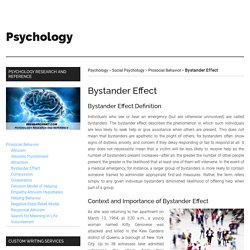
The bystander effect describes the phenomenon in which such individuals are less likely to seek help or give assistance when others are present. This does not mean that bystanders are apathetic to the plight of others, for bystanders often show signs of distress, anxiety, and concern if they delay responding or fail to respond at all. It also does not necessarily mean that a victim will be less likely to receive help as the number of bystanders present increases—after all, the greater the number of other people present, the greater is the likelihood that at least one of them will intervene. In the event of a medical emergency, for instance, a larger group of bystanders is more likely to contain someone trained to administer appropriate first-aid measures. Bystander Effect - Definition, Examples and Experiment. Bystander Effect Definition.
Bystander Behavior – Association for Psychological Science – APS. Diffusion of Responsibility - IResearchNet. Diffusion of responsibility is a concept that has been employed in several fruitful ways in psychology.
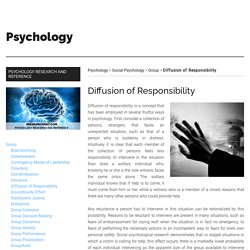
First, consider a collection of persons, strangers, that faces an unexpected situation, such as that of a person who is suddenly in distress. Intuitively it is clear that each member of the collection of persons feels less responsibility to intervene in the situation than does a solitary individual who, knowing he or she is the sole witness, faces the same crisis alone. Social influence and diffusion of responsibility in an emergency. What is Diffusion of Responsibility? Mental Health What is Diffusion of Responsibility?
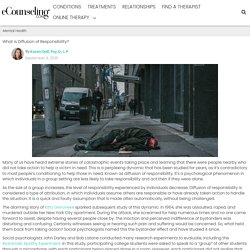
By Karen Doll, Psy.D., L.P September 9, 2020. The sense of social influence: pluralistic ignorance in climate change. The Role of Pluralistic Ignorance in the Reporting of Sexual Harassment: Basic and Applied Social Psychology: Vol 31, No 3. THE IRRATIONALITY OF PLURALISTIC IGNORANCE. Understanding pluralistic ignorance in organizations: application and theory.
Pluralistic Ignorance (SOCIAL PSYCHOLOGY) - iResearchNet. Pluralistic Ignorance Definition Pluralistic ignorance occurs when people erroneously infer that they feel differently from their peers, even though they are behaving similarly.
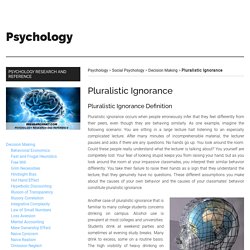
As one example, imagine the following scenario: You are sitting in a large lecture hall listening to an especially complicated lecture. After many minutes of incomprehensible material, the lecturer pauses and asks if there are any questions. No hands go up. You look around the room. Another case of pluralistic ignorance that is familiar to many college students concerns drinking on campus. Pluralistic ignorance and social change new 1027. I Want to but I Won't: Pluralistic Ignorance Inhibits Intentions to Take Paternity Leave in Japan. Introduction Paternity leave refers to a father's taking a temporary leave of absence from work to care for a newborn.

Parental roles have traditionally been gendered in families with young children; that is, men have been primarily responsible for earning and women for caring. However, most OECD countries today provide statutory paternity leave to encourage gender equality between parents (Hegewisch and Gornick, 2011; Mun and Brinton, 2015). Bystander effect: Famous psychology result could be completely wrong. By Grace Browne SolStock/Getty If you were being attacked, would anyone stop to help you?
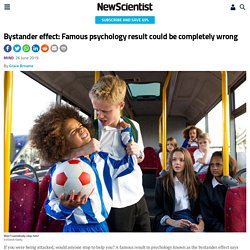
The bystander effect - Economic and Social Research Council. Bystander Effect: What Is It and What You Can Do About It. What the bystander effect looks like A little after 3 a.m. on March 13, 1964, Catherine “Kitty” Genovese parked her car and walked to her apartment in Queens, New York, after finishing her shift as a bar manager. Serial killer Winston Moseley was out to victimize someone that night. Genovese became his target. When he followed her, she ran.
Would I be helped? Cross-national CCTV footage shows that intervention is the norm in public conflicts. Bystander intervention in emergencies: Diffusion of responsibility. - PsycNET. APA PsycNet. Diffusion of responsibility in crime, punishment, and other adversity. Bem, D.
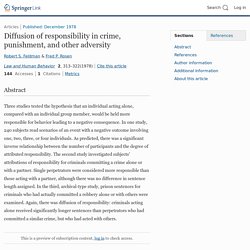
J. Self-perception theory. In L. Berkowitz (Ed.) ,Advances in Experimental Social Psychology, Vol. 6. From Empathy to Apathy: The Bystander Effect Revisited - Ruud Hortensius, Beatrice de Gelder, 2018. When people are asked whether they would spontaneously assist a person in an emergency situation, almost everyone will reply positively.
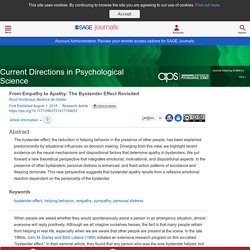
Although we all imagine ourselves heroes, the fact is that many people refrain from helping in real life, especially when we are aware that other people are present at the scene. In the late 1960s, John M. THE BYSTANDER EFFECT. The Bystander Effect:The Death of Kitty Genovese. The bystander effect is complicated. Defeating the Bystander Effect - How to Act as a Good Samaritan Durin… Doesn’t the Emperor have some nice new clothes? – The Science PT. The Emperor’s New ClothesIllustration by Vilhelm Pedersen, Andersen’s first illustrator In The Emperor’s New Clothes by Hans Christian Andersen, the Emperor hires two weavers to make him a new suit of clothing.

The weavers provide no actual clothes but swindle the Emperor by telling him that the “fabric” is invisible to those who are unfit in their position or “hopelessly stupid”. Of course, since there is no fabric at all, NO ONE can see the clothes. But what happens? Does anyone admit that they cannot see the clothes? Yes, you already know this children’s story. Because you’ve been guilty yourself. You’re in the middle of lab session at a course palpating the anterior hip and the instructor says, “You should now be able to feel the psoas tendon. Mugatu expresses his concern… This is not unique to you. It is a phenomenon known as pluralistic ignorance. It is also known as The Abilene Paradox and it is extremely damaging to societies, professions, and work environments. In summary… Helping Kids Overcome the Bystander Effect.
Newscasters love to share stories of kids as young as three years old calling 911 to save a parent’s life. These stories bear out what research has shown us: Very young children have a propensity to be kind and helpful. Starting as early as 18 months, studies show, toddlers spontaneously help an adult who is unable to pick up something he dropped or finds himself in a similarly tricky situation. Being kind at a cost to themselves makes two year olds happy, and three year olds who cooperate on a task share rewards even when they don’t have to. How to reverse the Bystander Effect. You see a shopper trip over in a busy street. Someone else can help. That’s what you tell your conscience. This is the Bystander Effect in action – the dilution of our sense of responsibility in the presence of other people – and it’s been demonstrated in numerous studies over many years.
But life is complicated and psychologists have begun looking at the circumstances that can nullify or even reverse the effect. For a new paper, Marco van Bommel and his team tested the idea that the presence of others could in fact increase our proclivity for helping if we’re nudged into a self-aware mindset and thereby reminded of our social reputation. Two experiments were conducted using an online chat room for people with extreme emotional problems.
APA PsycNet. Rethinking the Bystander Effect in Violence Reduction Training Programs - Levine - 2020 - Social Issues and Policy Review - Wiley Online Library. Introduction Violence reduction in general, and interpersonal violence reduction in particular, has been a key aim of global public health policies for the last three decades (Krug, Dahlberg, Mercy, Zwi, & Lozano, 2002). Psychological theories have played a key role in attempts to ensure a robust evidence base for the development of violence reduction interventions (Hollin, 2016; WHO, 2009). Early work drew on ideas about the psychology of perpetrators (Holtzworth‐Munroe & Stuart, 1994) or the psychology of victims (Seligman, 1972). More recently, however, there has been a recognition of the key role that can be played by bystanders and third parties in violence prevention (Banyard, 2011; Coker et al., 2011). What Is the 'Bystander Effect' and How Do People Overcome It?
This story appeared in the June 2020 issue as "Action! " Bystander intervention in a mild need situation. Beckman, L. Reducing the Bystander Effect. Heroism vs. The Bystander Effect. Source: Phil Zimbardo Many of us have been raised to try to live by the altruistic proverb known as “The Golden Rule”: Do unto others as you would have them do unto you.
But in more recent times, instead of being purely altruistic, “The Rule” seems to have bent to reflect reciprocal altruism: I’ll help others now and one day, when I need help, others will be there for me. And unfortunately, The Golden Rule is challenged on a daily basis. article continues after advertisement. Home.